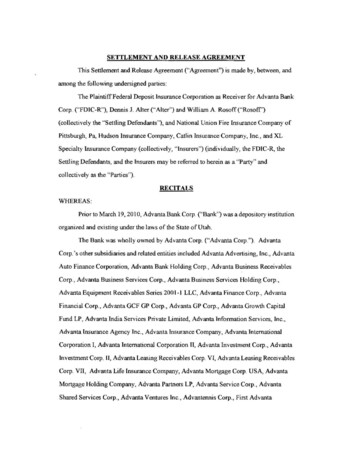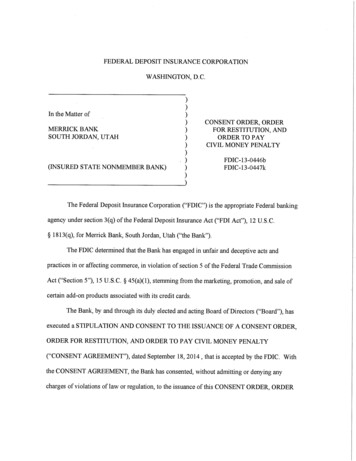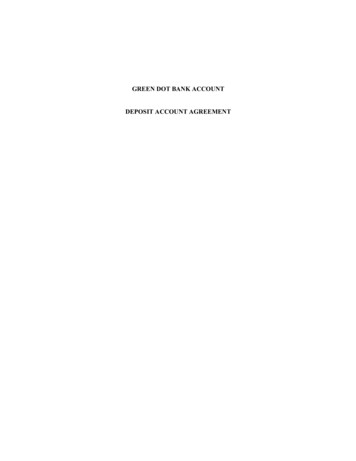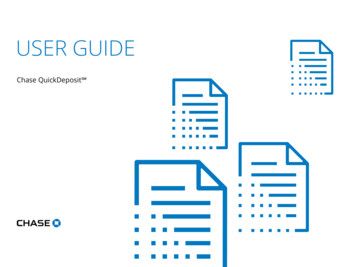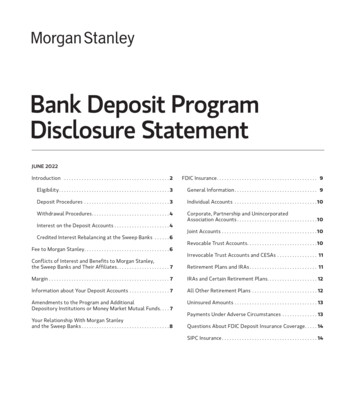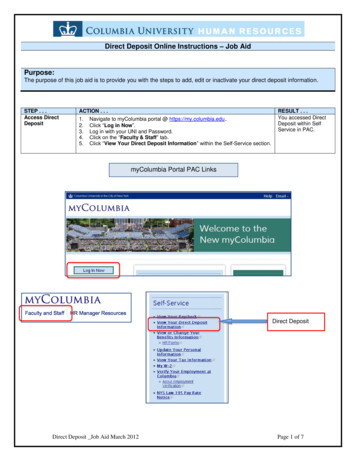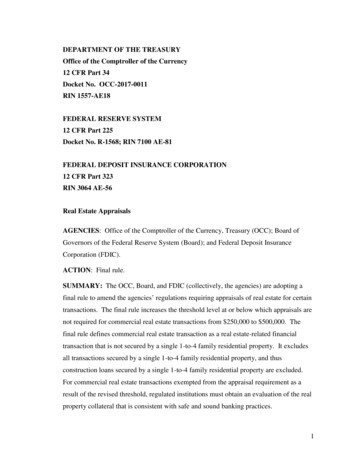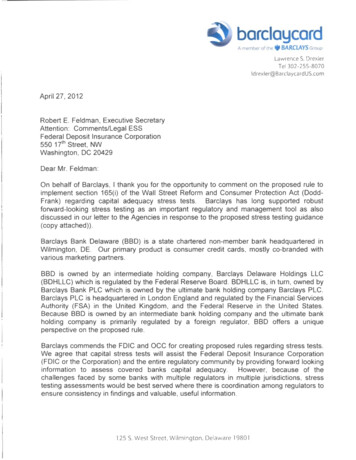
Transcription
barclaycardA member of tt1e BARCLAYS GroupLawrence S. DrexlerTel 302-255-8070ldrexler@BarclaycardUS.comApril 27, 2012Robert E. Feldman , Executive SecretaryAttention : Comments/Legal ESSFederal Deposit Insurance Corporation550 17'h Street, NWWashington , DC 20429Dear Mr. Feldman:On behalf of Barclays, I thank you for the opportunity to comment on the proposed rule toimplement section 165(i) of the Wall Street Reform and Consumer Protection Act (DoddFrank) regarding capital adequacy stress tests. Barclays has long supported robustforward-looking stress testing as an important regulatory and management tool as alsodiscussed in our letter to the Agencies in response to the proposed stress testing guidance(copy attached)).Barclays Bank Delaware (BBD) is a state chartered non-member bank headquartered inWilmington, DE. Our primary product is consumer credit cards, mostly co-branded withvarious marketing partners.BBD is owned by an intermediate holding company, Barclays Delaware Holdings LLC(BDHLLC) which is regulated by the Federal Reserve Board . BDHLLC is, in turn , owned byBarclays Bank PLC which is owned by the ultimate bank holding company Barclays PLC.Barclays PLC is headquartered in London England and regulated by the Financial ServicesAuthority (FSA) in the United Kingdom , and the Federal Reserve in the United States.Because BBD is owned by an intermediate bank holding company and the ultimate bankholding company is primarily regulated by a foreign regulator, BBD offers a uniqueperspective on the proposed rule.Barclays commends the FDIC and OCC for creating proposed rules regarding stress tests.We agree that capital stress tests will assist the Federal Deposit Insurance Corporation(FDIC or the Corporation) and the entire regulatory community by providing forward lookinginformation to assess covered banks capital adequacy. However, because of thechallenges faced by some banks with multiple regulators in multiple jurisdictions, stresstesting assessments would be best served where there is coordination among regulators toensure consistency in findings and valuable, useful information .125 5. West Street, Wilm1nglon. Delaware 19801
Robert E. Feldman, Executive SecretaryFDICPage 2We are also pleased to respond to the Corporation's specific request for commentsregarding the proposed timing and sequencing of the stress test and the time allotted underthe proposed rule. As discussed below, Barclays proposes that the testing should occurfrom March to June utilizing the static balance sheet as of the calendar year end .Common Stress Tests Across RegulatorsSince BDHLLC is regulated by the Federal Reserve, but its primary asset is BBD, which isregulated by the FDIC , stress tests required for both should be the same both substantivelyand procedurally. The interest of Dodd-Frank to create transparency regarding the healthof financial institutions is met by using the same test, and timing, for both the Bank and theintermediate holding company. Conversely, using different tests or different schedules willcreate burden on both entities and will disadvantage both vis-a-vis their competitors.Use of a Static Balance SheetThe starting point for running a stress test is the Bank's balance sheet. The Agencieswould benefit from basing the stress tests on a static balance sheet, assuming that theinstitution maintains the same business mix and model throughout the time horizontogether including any materially publicly announced changes 1 .The benefits of using a static balance sheet include:(i)results will be comparable across the span of regulated entities, providing alevel field and thus will provide a more meaningful indication of the healthand resilience of each institution ;(ii)the results are not based on differing outlooks and planning philosophiesacross banks, and so would provide consistency amongst banks;(iii)a static balance sheet mitigates the confidentiality concern because existingbusiness plans are not factored into the test; moreover, it ensures that banksare able to plan transactions that are in the interests of their stakeholderswithout communicating this to the market prior to implementation, which couldotherwise adversely affect their ability to implement such plans;Commencement of Stress Test in MarchThe Proposed Rule mandates that testing occur in November and December of each yearusing the balance sheet data "as of' September 30. Our preference would be to use the1A static balance sheet asc;umes Lero gro'.vth for both the baseline and the adverse scenarios. Asset' and liabilities thatmature during the time span or the test are assumed to be replaced by like instruments (in term ; or type, ri sk andmaturity). Defaulted assets arc not replaced thus the balance sheet reduces over the time horizon due to impairment. No\\Or!. out of defaulted assets is assumed. Regulated entities with unannounced material changes would liaise"' ith thef'D IC to determine how to include such material changes in the stress test., !::1 u ·n Wt-s trt U Wtlrntnoton L 'IJw r ' 198C l R 77 -:?00625
Robert E. Feldman, Executive SecretaryFDICPage 3static balance sheet approach for reasons outlined above, based on data as at year end .and therefore to move the timing of the test to commence in March following the completionof the year end reporting cycle.In the case that the FDIC elects not to use the static balance sheet approach for the stresstest, the timing of the stress test should be determined by the timing of the Bank's planningcycle. Integrating the stress test as part of the Bank's planning process will provide a clearforward looking view of the health of the institution that can be used to influence businessstrategies. However, to ensure a detailed level of assessment in line with internal stresstest processes, sufficient time should be provided to run the stress test taking into accountthat a Bank's planning cycle is typically one of the busiest periods of the business cycle fora bank.Three Months to Complete the Stress TestThe proposed rule suggests that the testing would occur in an eight week period . Thistimeframe is suitable for capital adequacy stress tests with a limited level of complexity, i.e.a static balance sheet and reliance on common methodology. Our experience shows that abottom up stress test process which is fully integrated in the financial planning processtypically requires about a three month time horizon . Generally the first week is consumedby analyzing the test scenarios and detailing the requirements for businesses to run thetest. That is followed by approximately four to five weeks for businesses to prepare for andrun the test, followed by a detailed review and challenge process. Thereafter, we expectinteraction with the FDIC and, potentially, more analysis.In summary, it is critical that the proposed rule anticipate coordination both substantivelyand procedurally for situations where multiple regulators will require stress tests of the bankand its intermediate holding company. Our preference is for the anticipated rule to providea process that utilizes a static balance sheet based on year end numbers with testing beingperformed and reported between March and the beginning of June of each year.We appreciate the Corporations consideration of the views set forth in this letter andwelcome the opportunity to discuss any part of this letter in greater detail.Lawrence DrexlerGeneral CounselBarclays Bank Delaware
tiiBARCLt\YSBy electronic submission to www.regulations.govBoard of Governors of the Federal Reserve System20th Street and Constitution Avenue, NWWashington, DC 20551Federal Deposit Insurance Corporation550 1?'h Street, NWWashington, DC 20429Office of the Comptroller of the Currency250 E Street, SWWashington, DC 2021928 1h July, 2011Re: Proposed Guidance on Stress Testing for Banking Organizations with more than 10 Billionin Total Consolidated AssetsBarclays appreciates the opportunity to respond to the proposed guidance issued by theAgencies regarding stress testing for US banking organizations with more than 10 billion inassets. We support the proposed guidelines, and believe that these are aligned with our ownview that robust, forward-looking stress testing is an important contributor to well-informed riskmanagement, including comprehensive assessments of capital and liquidity adequacy.We have additional comments in three areas specifically related to the design and operation ofbanks' enterprise-wide stress tests.1.Time horizonTo be most effective, it is important that banks estimate the impact of potential stress events overthe time horizon required to assess projected business performance through a range of plausibleadverse scenarios. Certain adverse scenarios are appropriately assessed under a shorter timehorizon, while for other scenarios a two-year horizon may be insufficient to evaluate the fullimpact of projected stress events. This is particularly important for understanding the risks in"traditional" retail and commercial banking operations, where there may be significant time lagsbetween the occurrence of adverse movements in the macroeconomic outlook, and consequentchanges in business performance. This point is empirically demonstrated by the fact that banksin some jurisdictions experienced declines in their capital ratios for periods that exceed the 24month horizon cited in the proposed guidance.Moreover, for some longer maturity portfolios, management actions taken to address the effectsof economic deterioration may take a significant period of time initially to affect the flow of newbusiness, and then to affect materially the composition and asset quality of the overall portfolios.Extending the time horizon to a third year is therefore valuable in enabling banks and regulators
to have an informed discussion of both the full impact of various scenarios, and banks' capacity tomitigate such scenarios by taking appropriate management actions.Indeed, it would be possible to argue for extending the time horizon further to four, or even five,years. However, we believe that other trade-offs start to outweigh the benefits of stress testingresults at that point. In particular, projecting over longer time horizons naturally brings greaterforecasting error, reducing the reliability of the results. Additionally, over longer time horizons, it isincreasingly likely that banks would be able to raise additional capital either by material assetsales or through additional capital issuance. Hence, as a test of capital adequacy, we believe thatthere is some natural limit to the time horizon over which it is necessary to project stressedperformance.2.Liquidity and capitalBarclays supports the proposed guidance that "an effective stress testing framework shouldexplore the potential for capital and liquidity problems to arise at the same time or exacerbate oneanother". Our experience is that it is important that both capital and liquidity are considered withinthe strategic and business planning processes, under both base case and a range of adversescenarios, and that the management body of the firm therefore has appropriate understanding ofboth the capital and liquidity risk associated with business plans.Some aspects of this interaction are amenable to incorporation within a single set of stressedbusiness performance and capital projections, such as: the increase in interest expense or lostinterest income when liquidity buffers are deployed under stress; the costs of re-establishing theliquidity buffer and the higher costs of raising debt in an adverse scenario; and revenue impactsand corresponding regulatory capital reductions that would result from reducing balance sheetgrowth in a stress scenario.However, capital adequacy is typically assessed over a multi-year adverse scenario, whereasliquidity adequacy is typically assessed over a much shorter horizon of a matter of weeks andmonths. While, this difference in time horizons means that capital and liquidity adequacyassessments do not lend themselves to being easily incorporated into a single set of projections,the interaction between capital and liquidity in certain stress events means that it is important thateach is considered in the context of the other in certain circumstances.The interaction between capital and liquidity, and its appropriate treatment within banks' stresstesting frameworks, is one in which we believe banks' and regulators' views of appropriatepractices may continue to evolve over the next few years, and we would welcome the opportunityto discuss this further.3.Legal entitiesIn addition to consolidated capital supervision, many large banks have material subsidiaries thatare also individually subject to local regulatory capital regimes. Banks in certain jurisdictions mayalso be subject to regimes, such as the UK FSA's Salus regime, in which certain sets of deposittaking entities are subject to separate capital standards. Adequacy of capital resources within aconsolidated banking group is therefore determined not just by the total amount of capital in thegroup, but also by the transferability of that capital between legal entity balance sheets within thegroup in a range of adverse scenarios. For banks with material subsidiaries, reflectingmovements of capital between the material entities- such as capital injections and dividend flows
between subsidiaries and parent companies- supports the overall assessment of the capitaladequacy of a banking group.One of the key considerations that legal entity stress testing can therefore enable largeinternational banks and their regulators to address is whether, in a severe stress, the availablecapital held at the parent level is sufficient to meet the potential need for capital injections into thebank's subsidiaries. To address this consideration effectively, we believe that it is important that:a)The overall assessment of capital adequacy is performed as part of a group-level stresstest which also incorporates subsidiary views (rather than standalone stress tests on thesubsidiary). In this case, banks should be able to demonstrate that the scenariosassessed in a group-level stress test appropriately stress the relevant subsidiariesb) A bank's home regulator leads the assessment of capital adequacy, taking intoconsideration the mitigating effects of parental support to subsidiaries.We appreciate the Agencies' consideration of the views set forth in this letter and welcome theopportunity to discuss any part of this letter in greater detail.Yours sincerely,Desmond McNamaraGroup Head of Economic CapitalBar clays
ldrexler@BarclaycardUS.com On behalf of Barclays, I thank you for the opportunity to comment on the proposed rule to implement section 165(i) of the Wall Street Reform and Consumer Protection Act (Dodd Frank) regarding capital adequacy stress tests. Barclays has long supported robust
